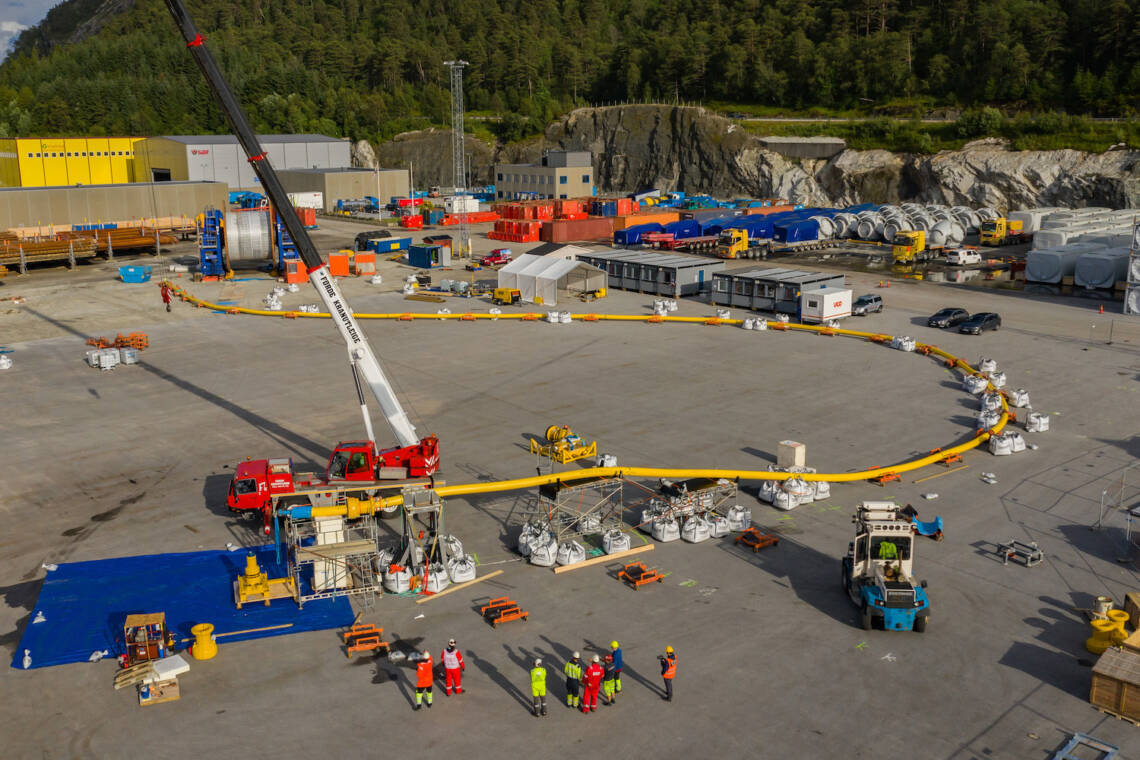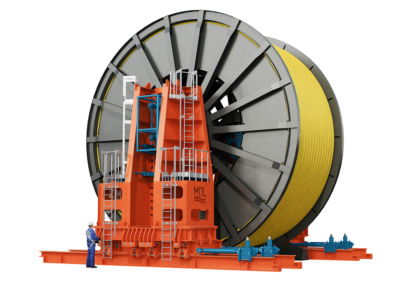Preparation is key to a long life subsea

“The beginning is the most important part of the work"- Plato
In our last blog of 2023, we explored the importance of optimised installation of cables for the floating energy platform's longevity. But - as mentioned - the deployment of the cable is only half of the story behind safe handling of delicate products. Before the cables begin their life subsea, they undergo multiple transition steps on land; so it makes sense to prioritise preserving their integrity from the moment they leave the manufacturing facility.
The topic of transpooling
Transpooling operations refer to the process of transferring a flexible product - such as cables and umbilicals - from one reel or spool to another. This tends to happen as the product leaves the manufacturing facility and is spooled into a storage facility.
Transpooling will also take place in preparation for installation - here’s why:
Optimising Installation Logistics: Flexibles are often stored on large reels or carousels, which are associated with transportation constraints. Transpooling allows for the transfer of the flexible onto smaller, more manageable reels that can be easily loaded onto installation vessels - or straight into the vessel's carousel.
Managing Vessel Capabilities: Installation vessels typically have specific equipment and size limitations for loading and deploying flexibles. Transpooling ensures that the equipment is transferred onto reels that are compatible with the vessel's capabilities, or straight into the vessel’s own infrastructure, facilitating a smoother installation process. Precise transpooling into a carousel will also ensure proper packing to maximise available space.
Reducing Installation Time: Preparing the flexibles before installation can save time during the actual deployment. It ensures that the flexible pipe or umbilical is prepared and configured for optimal installation under various conditions. Additionally for reels, these are easier to mobilise and deploy on the installation vessel, in a desired order without being tied to the constraints of long product lengths - streamlining the installation process and potentially reducing idle time.
Execution Flexibility: Transpooling provides flexibility in adapting to different project requirements and vessel capabilities. It allows project planners to optimise the logistics based on vessel availability or transportation constraints.
The above factors result in minimised risks, improved efficiency for shorter time offshore and therefore a more sustainable project overall.
What does it take?
While common, transpooling is rarely a hot topic in advance of an offshore development programme - not until the project is in a live planning stage.
At that point, a number of challenges may be identified, including: reels that are unsuitable for offshore handling due to design, damage or age; vessel geometry and available space; or orientation of product within their storage location not aligning with the installation methodology.
Transpooling will help overcome these challenges; but to first identify them and then plan out the most optimal solution, you need a combination of three elements: design + engineering capability; safe handling equipment; and experienced Project Management.
Yes, that sounds like MDL!
Indeed; thanks to years of transpooling experience, we have the know-how and the PM&E expertise in-house to optimise product handling: to preserve it, prepare it for deployment and - when the time comes - dispose of it.
By now, you know a lot about our technology, designed and proven in safe flexible product handling; so let’s delve into the expertise that pulls everything together and makes sure the operation runs smoothly from start to finish.
Quayside Marshalling
In the context of offshore energy projects, quayside marshalling is a critical element in the overall logistics and supply chain management of the construction scope. Efficient quayside operations contribute to the successful and timely installation, through the following:
Logistics and coordination - to ensure that all elements are in place at the right time for optimum schedule. This includes arranging transportation, managing port services and inventory and organising the assembly process.
Quality control: Before flexibles are deployed - either onto a carousel or loaded out on the back deck on reels - they undergo quality control checks at the quayside. This ensures that all components meet the necessary safety and performance standards.
Loadout: Once the products are ready, they are mobilised onto chosen vessels that will transport them to the offshore site. This is a project in its own right, requiring appropriate planning and management of third-party services - something MDL is well experienced in through overseeing mobs and demobs of our portable back-deck equipment for over a decade.

Overcoming the FOW challenge - with no compromises
Delays or disruptions in any part of the supply chain can impact the overall project timeline - and when these are related to vessel availability, the problem grows to significant proportions.
The availability of specialised cable or mooring line installation vessels is a known concern for offshore wind later this decade. In order to progress with these developments at pace, at MDL we advocate for smart vessel conversions, using proven flex-lay equipment (see our May newsletter).
The wider pool of tonnage will mean various mobilisation options for the product on board. We’ve covered the main flexible storage and deployment options in the November issue, but let’s look at these again from the quayside marshalling perspective.
- For vessels equipped with on-board carousels, particularly for longer cable lengths, a common practice will be to transpool the flexibles from the quayside onto the vessel. We have recently done just that for DEME and their cable replacement scope on an Offshore Windfarm. Thanks to the portability of our equipment and expertise of our team, we executed the transpooling at the client’s facility in Holland within 5 days of receiving the enquiry.
- For cables and mooring rope stored on reels, the quayside ops will revolve around safe lifting and mobilisation on board - a typical operation in our book. In some cases, the transpooling mentioned in point 1 may happen on board the vessel while still in port - as was the case ahead of this project for DOF in Australia. Our personnel supported the client team in efficient loading of the cables into the under-deck carousel; after which point, our transpooling spread was demobbed and packed up for road transport back to base in Scotland.
In either case, the principles of optimised handling that we discussed in our last blog still very much apply - and that’s why our forward-thinking technology is perfect for the task, ensuring no compromises to the products’ integrity at the start of their working life.

Managing the uncontrollable
However, an added bonus beyond safety is the efficiency and flexibility with which these scopes can be carried out, if planned correctly and using the right tools. These relate to one major aspect which project teams cannot control, but they can mitigate: the weather.
Changing weather conditions have a detrimental impact on offshore projects, but can also delay quayside operations, where overhead lifting is required. Use of cranes in such conditions is often curtailed, resulting in operations postponed or repeatedly paused, and that leaving personnel and vessels on standby - the latter idly burning away fuel and hours in port, putting further strain on already fragile budgets.
The easy answer would be to minimise crane usage - and that may be possible with cable and mooring rope load outs.
Let’s take an example of loading out a polyester mooring rope onto an Anchor Handling Tug Support vessel (AHTS). Traditionally, this would be carried out using overhead cranes to mobilise individual reels of product onto a spooler to then feed into the AHTS' drums - an operation involving continuous crane use and suspended heavy loads, susceptible to adverse weather.
Using an MDL RDS with an integrated track system allows to pre-mobilise multiple reels in-line even before the vessel's arrival in port (outside critical operations) and deploy all reels in the desired order (potentially out of sequence) without the use of the crane.
Advantages of an MDL RDS shoreside solution include:
- Reduced vessel idle time in port
- Crane use minimised to only the mobilisation stage
- Automation for personnel safety and operational efficiency - a complete spool is 4x quicker than spooler-based approach

Trust the Experts for project success
The above examples demonstrate the benefits behind MDL’s Integrated Services - our comprehensive approach to transpooling operations and other challenges surrounding flexible product handling.
Our expert support entails:
Project Management & Engineering with draughting and visualisation capability - delivering Just-in-Time logistics, including port services, schedules, procedures, and certifications.
Market-leading portable equipment – safest handling systems tailored to the scope and location, operated by an expert field service team.
Innovation – enabling safer and more efficient operations, through spoolbase upgrades, tailored storage solutions and full spreads for cables or mooring lines - all to ensure optimal handling under tension for product longevity.
Sounds like something your onshore facility or project could benefit from? Let’s talk!

- April 2024MDL supports Saipem on Greece INGS
- January 2024Preparation is key to a long life subsea
- January 2024Forward thinking with Holland
- January 2024Ensuring peak performance for FPSO and platform owners in 2024
- December 2023Reducing the risk of cable failures










